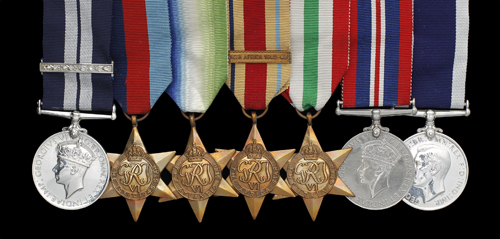
Auction: 1008 - Orders, Decorations, Campaign Medals & Militaria
Lot: 24
Family Group: A Rare Second War Submariner´s ´1940´ D.S.M. and ´1942´ Second Award Bar Group of Seven to Chief Engine Room Artificer L.T.J. Manuel, Royal Navy, Having Been Decorated For His Services in H.M.S. Rorqual in the Mediterranean, 1940; Manuel Went on to Win a Bar As Alistair Mars´ Right Hand Man in H.M.S. Unbroken; Operating Out of Malta, 1942-43, Mars Described Manuel as ´The Best Chief Petty Officer Who Ever Served With Me.´ a) Distinguished Service Medal, G.VI.R., with Second Award Bar (MX.47540 L.T.J. Manuel. C.E.R.A., R.N.), officially renamed b) 1939-1945 Star c) Atlantic Star d) Africa Star, with North Africa 1942-43 Bar e) Italy Star f) War Medal g) Naval Long Service & G.C., G.VI.R. (M. 47540. L.T.J. Manuel. C.E.R.A. H.M.S. Elfin.), generally good very fine, with the following related items: - Painted bronze Ship´s Crest Plate for H.M.S. Tabard, 270mm x 175mm - Chief Petty Officer bullion cap badge - Copy of Unbroken, The Story of a Submarine, by Alastair Mars, D.S.O., D.S.C., with a personal inscription to the recipient, ´To Leslie Manuel, without whom little would have been possible, in memory of the vital days of the "Fighting 42", with Warm Regards, Alastair Mars, 8.11.53´ - Letter to recipient´s son from Alastair Mars, dated 4.5.1976 - Original Certificate of Service - Certificate For Wounds and Hurts, dated 23.3.1943 - Two Admiralty letters of Appointment to Approve the Awards of the D.S.M. and Second Award Bar - Invitation to Investiture at Buckingham Palace, dated 9.11.1943 - Release From Naval Service Document, dated 22.4.1952, and Interim Trade Certificate with same date - Two Letters of reference, including from Commander W.G. Meeke, R.N. (Manuel´s C/O, H.M.S. Tabard, July 1948-December 1949), dated 13.4.1950 - Hong Kong Motor Driving Licence (whilst serving in H.M.S. Rorqual), dated 1.12.1937 - A large number of original and official photographs of the recipient and Submarines that he served in - Various newspaper cuttings; and four comprehensive files of research Four: Shipwright 1st Class J.H. Manuel, Royal Navy 1914-15 Star (133094, J.H. Manuel, Shpt. 1., R.N.); British War and Victory Medals (133094 J.H. Manuel. Shpt. 1. R.N.); Naval Long Service & G.C., V.R. (J.H. Manuel, Car. Mte. H.M.S. Tamar), very fine, with the recipient´s related miniature awards (lot) Estimate £ 2,500-3,500 D.S.M. London Gazette 1.1.1941 Chief Engine Room Artificer Leslie Thomas John Manuel, C/MX.47540 (H.M.S. Rorqual) D.S.M. Second Award Bar London Gazette 22.12.1942 Chief Engine Room Artificer Leslie Thomas John Manuel, D.S.M., C/MX.47540 (H.M.S. Unbroken) ´For gallant and distinguished services in Mediterranean War Patrols to August 1942´ Chief Petty Officer Leslie Thomas John Manuel, D.S.M., born Devonport, 1906; joined the Royal Navy as Engine Room Artificer 4th Class, October 1928; served in H.M.S. Sussex (Cruiser), 26.3.1929-17.7.1934; posted to H.M.S. Dolphin (Submarine Base, Gosport), July 1934; prior to the outbreak of the Second World War he served in H.M. Submarines Salmon and H34 and served in H.M.S. Rorqual (Grampus Class Minelaying Submarine), 21.11.1936-31.12.1940; the Rorqual was part of the 4th Flotilla, China Station, based at Hong Kong, 1937-1939; she was posted to Singapore in September 1939, and carried out patrols there until November of that year; after a re-fit she, and Manuel, were posted for service as part of the 1st Flotilla, Mediterranean, May 1940; arriving in Malta, 8.6.1940, she was immediately engaged in minelaying off Cyrenaica, off Ancona, west of Sicily, Gulf of Salonika and off Lemnos; between 10.6.1940-23.5.1941, Rorqual carried out 10 patrols totalling 156 days at sea, during which time she laid 450 mines in enemy waters and sank 7 ships by torpedo or gunfire; during this period Manuel and C.E.R.A. Harry Chown were repeatedly commended by their Captain, Commander Dewhurst, in his Patrol Reports for keeping the Rorqual afloat and ready to attack; in particular on the 4th July, ´Great credit is due to Ch.E.R.A. Harry Chown and Act. Ch.E.R.A. Leslie Manuel for the skilful work they carried out under very difficult conditions, which were lack of space, lack of ventilation and the great noise of the propellers. The success of this work was much appreciated during an eighteen hour dive, of which six where spent at 130-190 feet escaping from A/S craft. During this period the tank only leaked to the extent of 70 galls. Complete repairs were carried out during an eight hour docking at Malta´ and on the 21st July during an abortive attack on an Italian cargo ship - the first two torpedoes fired had failed to explode and the third ran hot in the tube whilst they were carrying out the reload; as Up Periscope relays, Rorqual did also have some very successful days, ´She was patrolling at periscope depth off the Coast of North Africa one afternoon in August, 1940, when smoke was sighted on the horizon. The sea was a flat calm, there was not a cloud in the sky and the sun beat down fiercely while the men in the Rorqual sweated at their stations. Manipulating the periscope, the captain made out a convoy of two merchant ships escorted by a destroyer three miles ahead and determined to have a double shot at all three ships. He must have known that he was trying to work something akin to a miracle in attempting to destroy the three ships at once, but that did not prevent him from trying. With the result that he sank the two merchantmen of 5,000 and 3,000 tons. The destroyer which he missed pounced down on him quickly, and shook the Rorqual with a well aimed pattern of depth charges. But the submarine suffered no severe damage, and when Commander Dewhurst came up to periscope depth to inspect the scene, he found that the two merchant ships had sunk. By December, 1940, the ribbon of the D.S.O. appeared on his jacket´; similarly for Manuel, whose D.S.M. appeared in the same gazette. H.M.S. Unbroken After a brief posting to H.M.S. Otus, Manuel served as Chief Engine Room Artificer in H.M.S. P42 (later renamed H.M.S. Unbroken), 21.5.1941-19.11.1943; laid down in December 1940 and launched in November the following year, she travelled out via Gibraltar to join the 10th Flotilla at Malta; captained by Lieutenant Alastair Mars, she and he undertook their first patrol together in March 1942, when she landed 3 SOE operatives (including Captain Peter Churchill, codename Michel) at Antibes in the South of France; this was the start of a very successful period for Unbroken; Mars who served with Manuel on the Unbroken until June 1943 and indeed went on to be awarded the D.S.O., D.S.C. and Bar, had this to say about his experienced C.E.R.A., ´He always has been a very modest man; also a most gallant one. He won the Bar to his D.S.M. in Unbroken (under my command) in 1942. Unbroken was, of course, P42. It was awarded for many months of highly dangerous - and often successful - service in that submarine. So there is no question of ´one act of gallantry´. There were scores. As captain, I had little experience of being depth-charged. Your father had, and ´held my hand´ not only in this respect; but in many others. Without any idea of belittling others, I can say that he was the best Chief Petty Officer (of all departments) who ever served with me.´ (letter to recipient´s son refers); the Unbroken returned to Malta, and at one point was the only submarine operating from the island, until United, Unruffled and Unrivalled joined; the besieged island was being progressively starved of food, ammunition and perhaps most importantly fuel; Unbroken served during Operation Harpoon, June 1942, as one of many attempts to get a convoy of supplies through the ever tightening Axis grip; the convoy was largely unsuccessful with only two merchantmen surviving the onslaught from Gibraltar to Malta; by the middle of July the island was on its last legs and it became imperative that supplies must get through, no matter the cost. Operation Pedestal A large convoy of 14 fast merchant ships was organized under the code-name Pedestal, ´Escorted by two battleships, H.M.S. Nelson and Rodney, three aircraft carriers, H.M.S. Eagle, Victorious and Indomitable, seven cruisers which included the anti-aircraft vessel H.M.S. Cairo, 24 destroyers, two tankers, four corvettes and eight submarines, the convoy slipped through the straits of Gibraltar under cover of dense fog during 10.8.1942...... Italian and German Intelligence organizations had become so aware of Pedestal that they were able to prepare a plan to intercept and destroy the convoy. This would be done jointly by 16 Italian and 5 German submarines attacking between the Straits of Algiers and the Sicilian Channel, and the 784 Axis aircraft, of which 537 would be bombers or torpedo-bombers would take up the attack. 18 motor torpedo-boats would be on hand between Cap Bon and Pantellaria, best to operate at night, while 6 cruisers and 11 destroyers of the Italian Navy would be held to finish off the convoy in concert with the aircraft´; Unbroken´s daylight patrol position for Pedestal was two miles north of Cape Milazzo lighthouse which lay 18 miles west of Messina naval base, Mars moved from this position, having been depth-charged, to just off Stromboli and engaged and damaged the Italian heavy cruiser Bolzano and the Italian light cruiser Muzio Attendolo, putting them both out of action for over a year; Mars adds the following detail from his book Unbroken, The Story of A Submarine: ´My heart thumped like a trip-hammer, but I noticed with satisfaction that my hands were steady and my eyes were clear. Then I saw them as their masts broke through the haze on the horizon. In my joy I could have danced a jig. "Bearing now?" "Green one." They were now well over the horizon. "Two..... Three....Four! Yes, four cruisers in line ahead, coming straight towards..... Range?" Chief E.R.A. Manuel read off from the range scale above my head. "Range, twelve thousand, sir." "Down periscope. Port twenty-five. Group up... Up after periscope."........... We shuddered as the propellers lashed the water and the submarine leapt across the enemy´s bows at her top speed. Assuming the cruisers kept to their course we would have to get some eight hundred yards off their path, turn around and fire. I had fifteen minutes in which to do this-just enough time. I then announced an item of information I had kept to myself. "There are eight modern destroyers and two seaplanes escorting. Shut off for depth-charging." As Haddow relayed the information to the rest of the boat, I felt a moment of queasiness. It was a feeling I knew of old-a boyhood memory of a twelve-stone brute flashing down the touchline of a rugger field, the full back at the other side of the field, and only myself to bring him down.... This time, however, I was not alone. I looked at the faces around me. Haddow, an enigmatic smile on his lips, watched the depth gauges like a lynx. On him depended whether I would be able to see or not when the moment of firing came. Thirsk was crouched low over his chart, oblivious to everything save the job in hand. Archdale gazed oddly at the fruit machine as though it was about to give birth. On him depended the director angle. Cryer, humped over the now repaired Asdic, had a grin on his face I can only describe as fiendish. E.R.A. Lewis hovered by the telemotor and blowing panels, watching the pressure indicators with deep concentration. Manuel stood behind me ready to read off the periscope and keep me clamped to the director angle at the time of firing...... We had to deliver a single, swift knock-out punch...... I swung the periscope. Two destroyers had passed fairly close. The third towered above me..... with a deafening roar she rushed past... Manuel´s breath was hot on my neck as he strained to keep me clamped to the director angle. As the destroyer´s stern flicked past my nose, the target came on my sights. "Fire One!"´ Unbroken had engaged the Italian Naval Squadron which had strangely been withdrawn by Mussolini from the attack on the convoy bound for Malta; Operation Pedestal despite extremely high cost managed to bring enough supplies to Malta to last until November, and give a timely morale boost. Wear and Tear and More Success Mars was pushing his small submarine to its limits and from the 11th-20 October 1942, the Unbroken ran a series of four patrols which culminated in an engagement off Lampion Island on the 19th; the convoy consisted of one large merchant vessel (7,000 tons), one tanker (8,000 tons) and one smaller merchant vessel, escorted by at least four destroyers, two seaplanes and one flying boat; the Unbroken managed to get off four torpedoes, but without success, before being subjected to an accurate and swift counter attack by depth-charges; she was badly damaged and once again Manuel was commended for his conduct in his Captain´s Patrol Report; during her time in the Mediterranean, she sank a further four Italian vessels and damaged at least another two; at the end of November 1943, weeks before Unbroken was to return to the UK, Manuel was posted for instructional duties to H.M.S. Elfin; he stayed in this role until October 1944; subsequent postings included in H.M. Submarines Tasman and Tabard; Manuel was discharged to Pension, 8.6.1952, after 24 years service with the Royal Navy. Shipwright 1st Class John Howell Manuel, born Plymouth, Devon, 1865, the father of Leslie Thomas John Manuel; joined the Royal Navy as Carpenters Crew, 1885; advanced Leading Shipwright, 1893; service during the Great War included in H.M.S. Donegal (Cruiser), April 1914-April 1916; discharged 7.4.1919.
Sold for
£4,000




